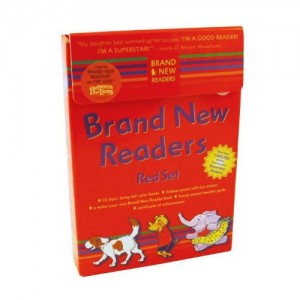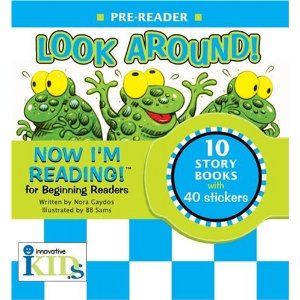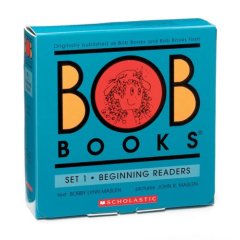Brand New Readers curriculum EFL eikaiwa ES kids language courses readers Reading Review reviews school management teaching
by sendaiben
2 comments
Brand New Readers
Continuing my series of children’s reader reviews, I’d like to talk about a little-known gem today.
Brand New Readers (official site here) have a terrible, genetic name, but are actually wonderful.
They are not phonics-based, but rather are short, well-written, engaging stories with very attractive illustrations and great characters. They are available from Amazon.jp in a variety of formats, including hardcover books with several stories and boxed sets of paperback individual stories. We have both, and get a lot of use out of them. The boxed sets in particular are great value: they cost less than 1000 yen for ten books, some stickers, and a couple of other certificates and parent/teacher guides.
My take on the series:
1. great characters and stories (I like Piggy and Mouse the best)
2. easy to read and fairly repetitive, useful language
3. not phonics-based, but good for students starting out with reading post-initial phonics
4. great value
I love this series, and recommend it both for storytelling in class (the stories are just the right length to read one or two at the end of the class) and for students to read individually, either in class or at home.
curriculum EFL ES extensive reading kids phonics readers Reading reviews school management teaching
by sendaiben
2 comments
Now I’m Reading phonics readers
Now I’m Reading is a phonics program consisting of five levels of books, from pre-reading to independent. The books come in packs of 10 in a durable and attractive binder. Books can be read as a set or taken out to be read individually. The official website contains lots of information about the series, as well as downloadable activities.
Like Bob Books, this is also a great value option. One set is just over 1300 yen from Amazon.jp, making individual books cost about 130 yen. The production values are better than Bob Books: the binders are excellent and the books are printed in colour on thicker paper. The illustrations are also very attractive.
My take on the books:
1. the books are attractive and appealing to students (I like them too)
2. the pre-reader level (pictured above) makes great mini-story books to read aloud in class (it is not phonically graded)
3. the phonics levels are well-structured, but the stories suffer somewhat from phonics-itis (where the story comes second to the phonics target, resulting in awkward or boring stories)
4. great value
5. easy for students to read individually in class or take home for homework
On the whole, I am quite a fan. While they are not as good as Jelly and Bean (mainly because of how the phonics stories are constructed), they are much cheaper and clearly better than similar products in the same price range. If nothing else I really recommend the pre-reader level as really cheap story books.
Has anyone else used Now I’m Reading?
curriculum EFL eikaiwa ES extensive reading kids language courses phonics readers Reading reviews teaching
by sendaiben
leave a comment
Bob Books children’s phonics readers
Bob Books are a great low-cost option for schools that want to start phonics practice with students but don’t have the funds available for more extensive purchases.
The newest version consists of five sets (each containing twelve books), which are available from Amazon.co.jp for just over 1200 yen. As this works out at just over 100 yen per book, they are excellent value for money. There are also older versions that contain similar books in slightly different configurations with different names.
We bought our Bob’s Books quite a few years ago, and used them until we found Follifoot Farm. We haven’t really used them since.
My thoughts on the series:
1. the phonics progression is handled quite well, and they are decodable
2. the language used in the books is not graded, making them somewhat challenging for EFL students at times
3. they feel quite cheap, being printed on thinner paper in black and white
4. the pictures are simple line drawings
5. I feel the stories are not particularly inspired, and many of them are driven solely by the phonics rather than the story itself
In short, these are a cheap and relatively effective option. They are certainly better than nothing, but they are not in the same league as Follifoot Farm. If you can’t afford anything else, they will at least get your students reading.
Anyone else use Bob Books?
Admin EFL extensive reading kids language courses readers Reading Review teaching
by sendaiben
6 comments
Children’s Readers Roundup
Rather than try to come up with a new topic every couple of days, I have decided to review all the children’s readers we use and write one post for each series. That should keep me going for a while, and hopefully turn into a useful resource for teachers considering their next purchase.
I have written briefly about a couple of series on the blog:
Story Street (10.12.22)
Oxford Reading Tree (10.10.23)
SRA (09.08.13)
but they were all fairly superficial posts. I plan to go much more in-depth this time around. There will also be a big comparison post at the end.
I’m quite excited about this project.
There is just one concern, which is the legality of posting content as part of a review. Does anyone know what is acceptable with regards to posting photos (of text, artwork, the outside cover of the book, CDs, etc.) taken by me?
I will probably contact the publishers just to make sure, but any advice or experiences would be much appreciated!
curriculum EFL eikaiwa ES expectations extensive listening kids language courses Language learning listening school management self-study teaching
by sendaiben
6 comments
Practicing speaking with (young) learners
I am a strong believer in input-based learning, as that is how I best learn languages myself. However, recently I have started to question this approach, particularly but not exclusively for my younger students.
There does seem to be a ‘silent period’ for most learners, where they are more comfortable listening than speaking. This varies according to age and character, but seems to exist for all learners (even if it is just a few minutes for the most active/outgoing). I wouldn’t take it as far as this school (which enforces a silent period of about 6-8 months), but I like to keep it in the back of my mind.
The arguments for following a silent, input-heavy period seem pretty persuasive to me:
1. learners can get comfortable with the sounds of the language
This is important because if you can’t hear a sound, you’re unlikely to be able to produce it. There seems to be a case for delaying production until students have enough exposure to the sounds and rhythms of a language.
2. learners can become familiar with basic vocabulary and grammatical chunks
Assuming the input is at an appropriate level, learners will be able to hear the same vocabulary and grammatical chunks multiple times, beginning to acquire them.
3. learners can relax, lowering their affective filter and allowing them to focus on the language
This is pure TPR talk, but I find TPR extremely effective for beginners. Being able to sit back and not have to worry about performance seems to make it much easier for learners to pick up language.
However, this is a slow process. We’re talking about hundreds of hours.
In Japan, where most children learn English for an hour or less a week (elementary school age children at our school have 50-minute lessons), it is clearly not enough to expose children to appropriate input and wait for them to want to speak.
I think David Paul was very right to emphasise teaching children basic phonics so that they would be able to do reading and writing homework as soon as possible. I find children find it much easier to remember language when they have heard, said, read, and written it. It also has the happy side effect of seguing into extensive reading. Recently at Cambridge English we have been trying out various reader programs (Follifoot Farm, Story Street, Oxford Reading Tree, Springboard Readers, Rigby Star). On the whole students enjoy reading in class and for homework.
The other thing we have started doing recently is memorizing questions and answers and short dialogues. At first I wanted to make our own materials (something that may yet happen), but soon after that we came across MPI’s QA series, which does almost everything we want and saves us from reinventing the wheel. The books are not perfect, they have a few awkward questions in there and I’m not sure that the QA300 series really works, but they are cheap, easy to use, come with Japanese translations for students and parents to fall back on, and have CDs available.
So far I’ve been pleased with the results. Each student is set a few (2-10) questions to prepare each week, then has a test in their next class. If they can answer perfectly, they clear the question and get assigned new ones. If not, they review the same questions for the next class. Most students enjoy the challenge and are remembering more common questions. A few students love it and are shooting through the series, and some students are really struggling. As the students work individually at their own pace, this is not too much of a problem. On the whole , it’s been a positive development for our school.
So there we go. I still believe in input, but feel that it is not enough for a Japanese eikaiwa context. We supplement with reading and writing as well as memorising question and answer patterns, which seems to help but we’re still not completely where I would like us to be.
What do you think the most effective ways to teach children in an eikaiwa context are?




